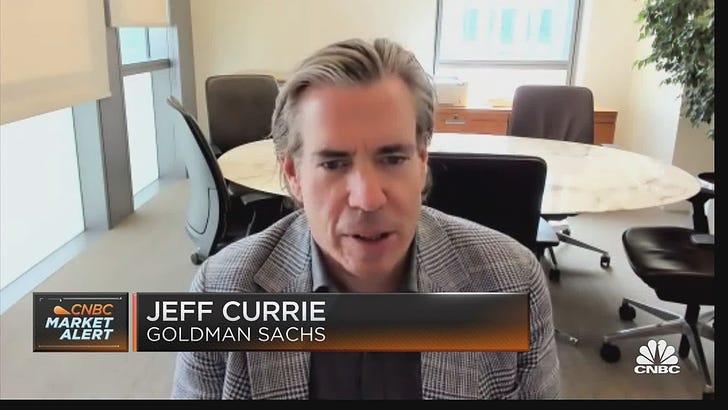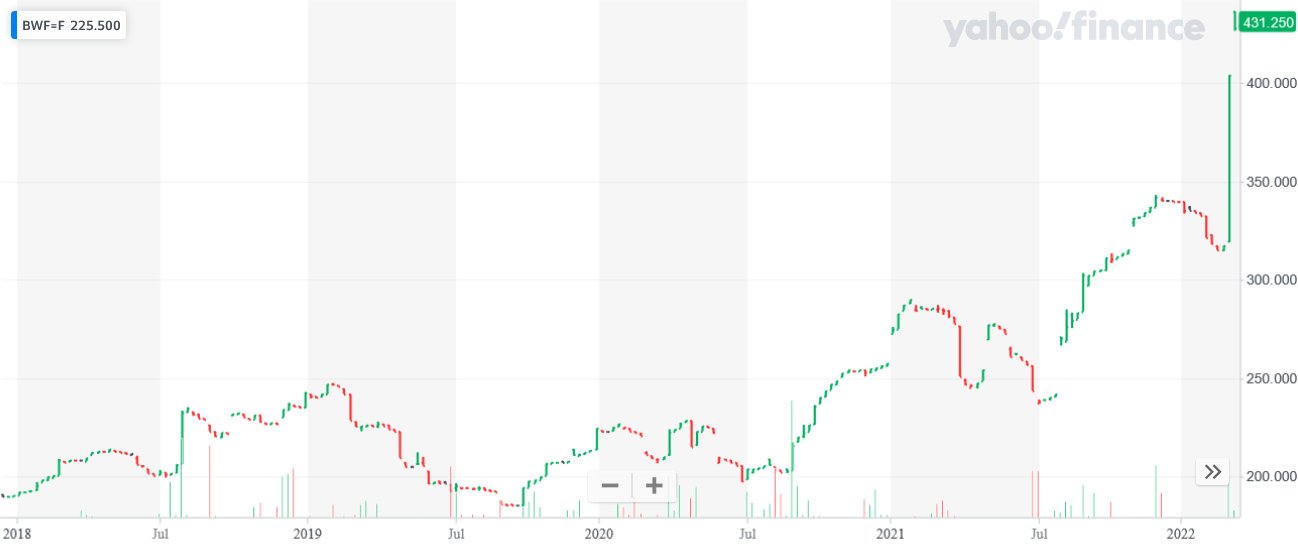I came across an interview on CNBC this week that does an excellent job of explaining why we are entering a super cycle in commodities. Here is the link:
In the above video, Jeff Currie of Goldman Sachs explains why supply constraints create demand destruction, which results in severe price hikes. It’s worth watching more than once.
Jeff says this super cycle will last multiple years. Most surprisingly, it’s not primarily in the oil & gas sector. He claims wheat and corn are in much worse shape in regards to global supply shortages. Wheat, in particular, is getting hit hard because of the Ukraine invasion by Russia. Ukraine is a major supplier for Africa, Europe, and Asia. Due to the war, the Ukrainians are missing the planting season this year. Jeff explains the impact will be a 25% shortage in wheat globally. Corn is also impacted with a 10-15% shortage expected. Corn futures contracts are now up about 35%, and wheat is shown on the 5 yr chart below.
This is the chart of Black Sea wheat
From a $200-$250 multiyear range ending about 18 months ago, it has now risen from $325 to over $400 since the start of the RU-UA war.
Similar charts are both in hard and soft commodities. Hard commodities are metals and ores like copper, steel, iron, nickel, potash and aluminum. Softs are grains, livestocks, coffee, OJ, cocoa, etc.
Most importantly, we are at the very beginning of this super cycle.
In this weeks Slay the SPiDeR video,
note the sectors that are in the upper left corner. I also noted that basic materials has now surpassed Healthcare and Industrials in ytd performance.
This means we need to get on board the supercycle during the downturn beginning this next week.
In looking at these commodities, the way to play these in stocks is as follows.
With rising corn and wheat prices, farm equipment makers like Deere (DE) and Catapillar (CAT) and Cummins (CMI) will benefit from increased sales, just like what happened in the previous 3 supercycles. Potash, used primarily for fertilizers, will also be in high demand. Mosaic (MOS) will prosper. In copper, Southern Copper (SCCO) and Freeport McMoran (FCX). FCX is the worlds leading copper producer.
If you examine the long-term charts of each of those stocks, you will find that all of them surged early in the super cycle, pulled back substantially in the recession caused by the demand destruction, then roared forward.
Here is the chart of SCCO since 1995
Note the move from 2003-2008.
Here is the chart of FCX since 1995
It went from $6 to $60+ in 5 years. You won’t see many stocks in Tech, Consumer Discretionary, or Communications do that in the next 5 years.
Nickel is in a double pickle. First, Russia is the largest producer, and China is the largest consumer. The Russian trade problem is obvious.
The London Metals Exchange (LME) is the largest metals commodity exchange in the world. Two-three weeks ago, China’s largest stainless steel-maker, and consumer of nickel in the world, shorted nickel in a big way, and got caught in a short squeeze on March 8th.. The price of nickel rose 111% in a single day, and the Chinese company was looking at $8 Billion, yes, with a B, in losses.
The LME decided to cancel all the trades for the day. Guess what? The LME was bought by HongKong Exchange (HKEX), a Chinese company, in 2012 . By cancelling the trades, it wiped out a significant amount of the losses incurred in the short squeeze. Then, the LME extended the time for the Chinese banks handling the trades to meet the margin calls. It’s quite outrageous that China squeezed the LME to do this. The Chinese also ordered the 2nd largest metals exchange, the Shanghai Futures Exchange, to support the LME move by closing nickel trading the next day as well.
Now, the traders and firms trading metals are in an uproar because the trust has been completely broken. I should elaborate - the traders on the losing side are pretty happy they got out of big losses. Traders and firms on the winning side of the trades are leaving LME as fast as possible, and LME volume of trading is at bare minimums while these traders and firms decide on where they need to go to get fair and honest trading instead of compromised results favoring a major customer and their banks.
It’s different than stock exchanges, because metals exchanges also warehouse tons and tons of these metals for delivery at futures contract maturity.
Here is a link to read more about this.
https://thediplomat.com/2022/03/nickel-short-saga-raises-questions-about-chinas-interference-in-international-markets/
It’s roiling other metals markets besides the nickel market. It will take a long time before all the lawsuits get resolved from this LME action.
The Chinese steelmaker had placed trades through more than 10 banks to create the short position and disquise the size of the short, including JPMorgan, Goldman Sachs, and Citibank. It’s a global mess.
You can buy the companies I recommended here at this time if you have a long-term perspective. Personally, I am waiting for a bit, at least till the May or June Fed meetings to see what happens with interest rates. There should be an opportunity to buy in at lower prices. That may not be true with oil & gas.
Biden committed the U.S. to supply a significant amount of LNG to replace the natgas that the Nord Stream II pipeline from Russia to Germany was expected to supply for Europe beginning in 2022.
Biden committed to far more supply than the U.S. can deliver this year. Not for production reasons, but because the U.S. simply does not have the capacity at the LNG loading terminals in the Gulf of Mexico to ship as much as Biden committed to shipping. The devil is always in the details.
On the bright side, the time until those terminals are up and running can be used to drill and build natgas capacity in the Permian Basin in West Texas, the Delaware Basin in New Mexico, and in the Bakken shale in North Dakota. It’s all got to grow to keep Europe warm, or cool, and happy.
Now, if we only had more pipelines to get it all to the Gulf Coast…
Let’s Go Get the Money
or at least keep what we have now.
JimB






Thanks Jim, very insightful.
I'm a bit confused about your timing. Near the start you say "This means we need to get on board the supercycle during the downturn beginning this next week.", but nearer to the end you say "You can buy the companies I recommended here at this time if you have a long-term perspective. Personally, I am waiting for a bit, at least till the May or June Fed meetings to see what happens with interest rates."
And what are your thoughts about buying actual farmland, either via REITs like FPI and FARM, or through crowdsourcing platforms?
Thanks,
Steve